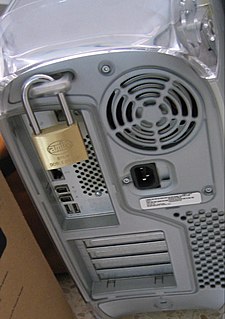
Computer security, cybersecurity or information technology security is the protection of computer systems and networks from the theft of or damage to their hardware, software, or electronic data, as well as from the disruption or misdirection of the services they provide.
Interoperability is a characteristic of a product or system, whose interfaces are completely understood, to work with other products or systems, at present or in the future, in either implementation or access, without any restrictions.

The Defense Information Systems Agency (DISA), known as the Defense Communications Agency (DCA) until 1991, is a United States Department of Defense (DoD) combat support agency composed of military, federal civilians, and contractors. DISA provides information technology (IT) and communications support to the President, Vice President, Secretary of Defense, the military services, the combatant commands, and any individual or system contributing to the defense of the United States.
Supervisory control and data acquisition (SCADA) is a control system architecture comprising computers, networked data communications and graphical user interfaces (GUI) for high-level process supervisory management, while also comprising other peripheral devices like programmable logic controllers (PLC) and discrete proportional-integral-derivative (PID) controllers to interface with process plant or machinery. The use of SCADA has been considered also for management and operations of project-driven-process in construction.

The National Cyber Security Division (NCSD) is a division of the Office of Cyber Security & Communications, within the United States Department of Homeland Security's Cybersecurity and Infrastructure Security Agency. Formed from the Critical Infrastructure Assurance Office, the National Infrastructure Protection Center, the Federal Computer Incident Response Center, and the National Communications System, NCSD opened on June 6, 2003. The NCSD mission is to collaborate with the private sector, government, military, and intelligence stakeholders to conduct risk assessments and mitigate vulnerabilities and threats to information technology assets and activities affecting the operation of the civilian government and private sector critical cyber infrastructures. NCSD also provides cyber threat and vulnerability analysis, early warning, and incident response assistance for public and private sector constituents. NCSD carries out the majority of DHS’ responsibilities under the Comprehensive National Cybersecurity Initiative. The FY 2011 budget request for NCSD is $378.744 million and includes 342 federal positions. The current director of the NCSD is John Streufert, former chief information security officer (CISO) for the United States Department of State, who assumed the position in January 2012.

The Homeland Security Act (HSA) of 2002, was introduced in the aftermath of the September 11 attacks and subsequent mailings of anthrax spores. The HSA was cosponsored by 118 members of Congress. The act passed the U.S. Senate by a vote of 90-9, with one Senator not voting. It was signed into law by President George W. Bush in November 2002.

The Combat Capabilities Development Command (CCDC) C5ISR Center, formerly the Communications-Electronics RD&E Center (CERDEC), is the United States Army information technologies and integrated systems center. CCDC C5ISR Center is headquartered at Aberdeen Proving Ground in Maryland, with activities at Fort Belvoir in Virginia and Joint Base McGuire-Dix-Lakehurst in New Jersey.
The Defense Information System Network (DISN) has been the United States Department of Defense's enterprise telecommunications network for providing data, video and voice services for 40 years.
A cyber fusion is an intelligence gathering, analysis and dissemination state or major urban area center, which is owned by state, local, and territorial law enforcement and Department of Homeland Security entities, many of which were jointly created between 2003 and 2007 under the U.S. Department of Homeland Security (DHS) and the Office of Justice Programs in the U.S. Department of Justice. The DHS Office of Intelligence and Analysis (I&A) and Federal Emergency Management Agency (FEMA) provide Fusion Centers with resources, training, and other coordinated services. The goal of such centers are to strengthen National anti-terrorism networks within the U.S. Federal government.

The Network Centric Operations Industry Consortium (NCOIC) is an international not-for-profit, chartered in the United States, whose goal is to facilitate the adoption of cross-domain interoperability standards. Formed in September 2004, the organization is composed of more than 50 members and advisors representing business, government organizations and academic institutions in 12 countries.

The Internet of things (IoT) is a system of interrelated computing devices, mechanical and digital machines provided with unique identifiers (UIDs) and the ability to transfer data over a network without requiring human-to-human or human-to-computer interaction.
Einstein was originally an intrusion detection system that monitors the network gateways of government departments and agencies in the United States for unauthorized traffic. The software was developed by the United States Computer Emergency Readiness Team (US-CERT), which is the operational arm of the National Cyber Security Division (NCSD) of the United States Department of Homeland Security (DHS). The program was originally developed to provide "situational awareness" for the civilian agencies. While the first version examined network traffic and subsequent versions examined content, the current version of Einstein is significantly more advanced.
Physical security information management (PSIM) is a category of software that provides a platform and applications created by middleware developers, designed to integrate multiple unconnected security applications and devices and control them through one comprehensive user interface. It collects and correlates events from existing disparate security devices and information systems to empower personnel to identify and proactively resolve situations. PSIM integration enables numerous organizational benefits, including increased control, improved situation awareness and management reporting. Ultimately, these solutions allow organizations to reduce costs through improved efficiency and to improve security through increased intelligence.
Managed Trusted Internet Protocol Service (MTIPS) was developed by the US General Services Administration (GSA) to allow US Federal agencies to physically and logically connect to the public Internet and other external connections in compliance with the Office of Management and Budget's (OMB) Trusted Internet Connection (TIC) Initiative.

The Command, Control and Interoperability Division is a bureau of the United States Department of Homeland Security's Science and Technology Directorate, run by Dr. David Boyd. This division is responsible for creating informative resources(including standards, frameworks, tools, and technologies) that strengthen communications interoperability, improve Internet security, and integrity and accelerate the development of automated capabilities to help identify potential threats to the U.S.
The UCLA Smart Grid Energy Research Center (SMERC), located on the University of California Los Angeles (UCLA) campus, is an organization focused on developing the next generation of technologies and innovation for the SmartGrid. Partnerships with government, technology providers, DOE research labs and universities, utilities, policy makers, and electric vehicle and appliance manufacturers provide SMERC with diverse capabilities and exceptional, matured leadership.

The Cyber Security Division (CSD) is a division of the Science and Technology Directorate of the United States Department of Homeland Security (DHS). Within the Homeland Security Advanced Research Projects Agency, CSD develops technologies to enhance the security and resilience of the United States' critical information infrastructure from acts of terrorism. S&T supports DHS component operational and critical infrastructure protections, including the finance, energy, and public utility sectors, as well as the first responder community.
The Physical Security Interoperability Alliance (PSIA) is a global consortium of more than 65 physical security manufacturers and systems integrators focused on promoting interoperability of IP-enabled security devices and systems across the physical security ecosystem as well as enterprise and building automation systems.
SensorUp Inc. is an Internet of Things company based in Calgary, Alberta, Canada. SensorUp led the development of the Open Geospatial Consortium SensorThings API standard specification, an open and unified geospatial framework to interconnect IoT sensing devices, data, and applications over the Web. In 2014, SensorUp received funding supports from Natural Resources Canada's GeoConnections and TecTerra. In 2016, as part of the OGC Internet of Things pilot project SensorUp demonstrated its interoperable OGC SensorThings API platform solution at the Department of Homeland Security. Dr. Reginald Brothers, the Undersecretary of the Homeland Security Science and Technology, was "impressed with the ‘state of the practical’ where these various industry sensors can be integrated today using open standards that remove the stovepipe limitations of one-off technologies. " In March 2016 SensorUp submitted a new open source software project proposal, titled Whiskers, to the Eclipse Foundation. Whiskers will be an open source Javascript client library for the OGC SensorThings API and a light-weight OGC SensorThings API server for IoT gateways.
The Center for Internet Security (CIS) is a 501(c)(3) nonprofit organization, formed in October, 2000. Its mission is to "identify, develop, validate, promote, and sustain best practice solutions for cyber defense and build and lead communities to enable an environment of trust in cyberspace". The organization is headquartered in East Greenbush, New York, with members including large corporations, government agencies, and academic institutions.
![]()






